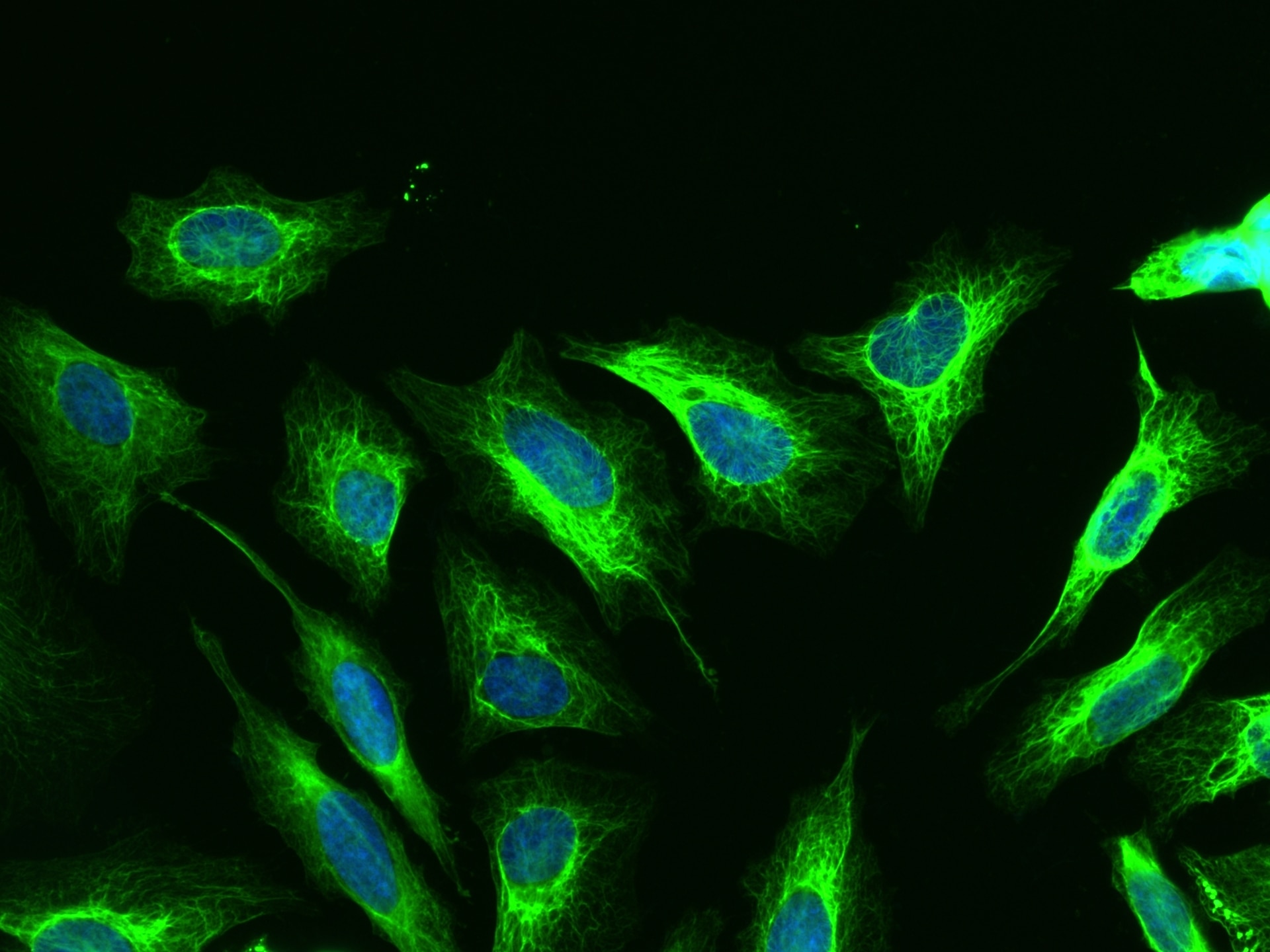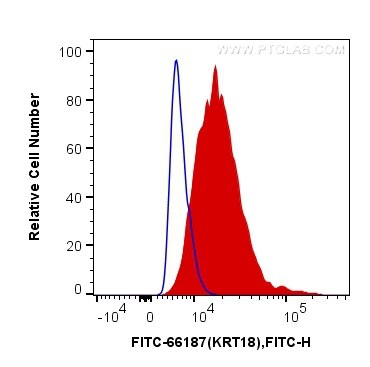Anticorps Monoclonal anti-Cytokeratin 18
Cytokeratin 18 Monoclonal Antibody for IF/ICC, FC (Intra)
Hôte / Isotype
Mouse / IgG1
Réactivité testée
Humain, porc, rat, souris et plus (1)
Applications
IF/ICC, FC (Intra)
Conjugaison
FITC Fluorescent Dye
CloneNo.
1G11C4
N° de cat : FITC-66187
Synonymes
Galerie de données de validation
Applications testées
| Résultats positifs en IF/ICC | cellules HeLa, |
| Résultats positifs en FC (Intra) | cellules HeLa |
| Résultats positifs en cytométrie | cellules HeLa |
Dilution recommandée
| Application | Dilution |
|---|---|
| Immunofluorescence (IF)/ICC | IF/ICC : 1:50-1:500 |
| Flow Cytometry (FC) (INTRA) | FC (INTRA) : 0.40 ug per 10^6 cells in a 100 µl suspension |
| Flow Cytometry (FC) | FC : 0.40 ug per 10^6 cells in a 100 µl suspension |
| It is recommended that this reagent should be titrated in each testing system to obtain optimal results. | |
| Sample-dependent, check data in validation data gallery | |
Applications publiées
| IF | See 3 publications below |
| FC | See 1 publications below |
Informations sur le produit
FITC-66187 cible Cytokeratin 18 dans les applications de IF/ICC, FC (Intra) et montre une réactivité avec des échantillons Humain, porc, rat, souris
| Réactivité | Humain, porc, rat, souris |
| Réactivité citée | bovin, Humain |
| Hôte / Isotype | Mouse / IgG1 |
| Clonalité | Monoclonal |
| Type | Anticorps |
| Immunogène | Cytokeratin 18 Protéine recombinante Ag1260 |
| Nom complet | keratin 18 |
| Masse moléculaire calculée | 48 kDa |
| Poids moléculaire observé | 48 kDa |
| Numéro d’acquisition GenBank | BC000180 |
| Symbole du gène | Cytokeratin 18 |
| Identification du gène (NCBI) | 3875 |
| Conjugaison | FITC Fluorescent Dye |
| Excitation/Emission maxima wavelengths | 498 nm / 526 nm |
| Forme | Liquide |
| Méthode de purification | Purification par protéine A |
| Tampon de stockage | PBS with 50% glycerol, 0.05% Proclin300, 0.5% BSA |
| Conditions de stockage | Stocker à -20 °C. Éviter toute exposition à la lumière. Stable pendant un an après l'expédition. L'aliquotage n'est pas nécessaire pour le stockage à -20oC Les 20ul contiennent 0,1% de BSA. |
Informations générales
Keratins are a large family of proteins that form the intermediate filament cytoskeleton of epithelial cells, which are classified into two major sequence types. Type I keratins are a group of acidic intermediate filament proteins, including K9-K23, and the hair keratins Ha1-Ha8. Type II keratins are the basic or neutral courterparts to the acidic type I keratins, including K1-K8, and the hair keratins, Hb1-Hb6. KRT18, also named as CYK18, PIG46 and K18, is the most commonly found members of the intermediate filament gene family. KRT18 is a type I keratin which is found primarily in non squamous epithelia and is present in a majority of adenocarcinomas and ductal carcinomas but not in squamous cell carcinomas.
Protocole
| Product Specific Protocols | |
|---|---|
| IF protocol for FITC Cytokeratin 18 antibody FITC-66187 | Download protocol |
| FC protocol for FITC Cytokeratin 18 antibody FITC-66187 | Download protocol |
| Standard Protocols | |
|---|---|
| Click here to view our Standard Protocols |
Publications
| Species | Application | Title |
|---|---|---|
J Dairy Sci Diacylglycerol O-acyltransferase (DGAT) isoforms play a role in peridroplet mitochondrial fatty acid metabolism in bovine liver | ||
Exp Ther Med Detection of PD‑L1 expression and epithelial‑mesenchymal transition of circulating tumor cells in non‑small cell lung cancer | ||
J Dairy Sci Caveolin 1 in bovine liver is associated with fatty acid-induced lipid accumulation and the ER unfolded protein response: role in fatty liver development |



